Blog - Foot Doctor, Chambersburg and McConnellsburg, PA
How to Tell If You Have Flat Feet
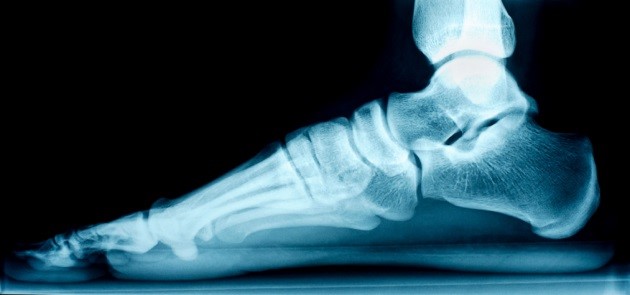 If you have flat feet, you may be a part of the 30 percent of people who experience problems from the condition. Symptoms of flat feet include back and leg pain and fatigue from walking often. In order to tell if you have flat feet, you can wet your feet, then stand on a piece of paper to make an imprint. If your foot shows a full outline on the paper, this means you have flat feet. If you do have flat feet, make sure to avoid and prevent things that can exacerbate your condition. Wearing high heels, being overweight, working long hours on your feet, and strenuous exercise can make the pain caused by flat feet much worse.
If you have flat feet, you may be a part of the 30 percent of people who experience problems from the condition. Symptoms of flat feet include back and leg pain and fatigue from walking often. In order to tell if you have flat feet, you can wet your feet, then stand on a piece of paper to make an imprint. If your foot shows a full outline on the paper, this means you have flat feet. If you do have flat feet, make sure to avoid and prevent things that can exacerbate your condition. Wearing high heels, being overweight, working long hours on your feet, and strenuous exercise can make the pain caused by flat feet much worse.
Flatfoot is a condition many people suffer from. If you have flat feet, contact Dr. Steven Schwartz from Pennsylvania. Our doctor will assist you with all of your podiatric concerns.
What are Flat Feet?
Flat feet are a condition in which the arch of the foot is depressed and the sole of the foot is almost completely in contact with the ground. Standing about 20-30% of the population generally has flat feet because their arch never formed during growth.
Conditions & Problems:
Having flat feet makes it difficult to run or walk because of the stress placed on the ankles.
Alignment – The general alignment of your legs can be disrupted, because the ankles move inward which can cause major discomfort.
Knees – if you have complications with your knees, flat feet can be a contributor to arthritis in that area.
Symptoms:
Pain around the heel or arch area
Trouble standing on the tip toe.
Swelling around the inside of the ankle.
Flat look to one or both feet.
Having your shoes feel uneven when worn
Treatment:
If you are experiencing pain and stress on the foot you may weaken the posterior tibial tendon, which runs around the inside of the ankle.
If you have any questions please feel free to contact our office located in Chambersburg and Mcconnellsburg, PA. We offer the newest diagnostic and treatment technologies for all your foot and ankle needs.
Gout: Major Condition in the UK
 Gout was found to be one of the most common conditions affecting people in the UK, as discovered by a 2014 study. Early-on diagnosis and treatment are both important for preventing progression of symptoms. Gout exists “as the third most common form of arthritis,” and is caused by increases in uric acid levels in the body, usually from consuming certain foods and drinks such as alcohol. See your doctor for proper diet management and weight management to help in the prevention of gout.
Gout was found to be one of the most common conditions affecting people in the UK, as discovered by a 2014 study. Early-on diagnosis and treatment are both important for preventing progression of symptoms. Gout exists “as the third most common form of arthritis,” and is caused by increases in uric acid levels in the body, usually from consuming certain foods and drinks such as alcohol. See your doctor for proper diet management and weight management to help in the prevention of gout.
Gout is a foot condition that requires certain treatment and care. If you are seeking treatment, contact Dr. Steven Schwartz from Pennsylvania. Our doctor will treat your foot and ankle needs.
What is Gout?
Gout is a type of arthritis caused by a buildup of uric acid in the bloodstream. It often develops in the foot, especially the big toe area, although it can manifest in other parts of the body as well. Gout can make walking and standing very painful and is especially common in diabetics and the obese.
People typically get gout because of a poor diet. Genetic predisposition is also a factor. The children of parents who have had gout frequently have a chance of developing it themselves.
Gout can easily be identified by redness and inflammation of the big toe and the surrounding areas of the foot. Other symptoms include extreme fatigue, joint pain, and running high fevers. Sometimes corticosteroid drugs can be prescribed to treat gout, but the best way to combat this disease is to get more exercise and eat a better diet.
If you have any questions, please feel free to contact our office located in Chambersburg and Mcconnellsburg, PA. We offer the newest diagnostic and treatment technologies for all your foot care needs.
Tres Tinkle Recovers from Surgery
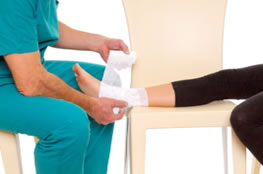 Tres Tinkle was spotted in late August stretching his leg with a resistance band, a workout meant to help rebuild the calf muscle strength he had lost from the past 4 months from recovery. The Oregon State forward was expected to return to court by mid-September, after one more appointment with foot specialist Donald Jones. Tinkle was wearing a walking boot and participating in physical therapy to rehabilitate and strengthen his leg muscles.
Tres Tinkle was spotted in late August stretching his leg with a resistance band, a workout meant to help rebuild the calf muscle strength he had lost from the past 4 months from recovery. The Oregon State forward was expected to return to court by mid-September, after one more appointment with foot specialist Donald Jones. Tinkle was wearing a walking boot and participating in physical therapy to rehabilitate and strengthen his leg muscles.
A broken foot requires immediate medical attention and treatment. If you need your feet checked, contact Dr. Steven Schwartz from Pennsylvania. Our doctor can provide the care you need to keep your pain free and on your feet.
Broken Foot Causes, Symptoms, and Treatment
A broken foot is caused by one of the bones in the foot typically breaking when bended, crushed, or stretched beyond its natural capabilities. Usually the location of the fracture indicates how the break occurred, whether it was through an object, fall, or any other type of injury.
Common Symptoms of Broken Feet:
- Bruising
- Pain
- Redness
- Swelling
- Blue (foot)
- Numbness
- Cold
- Misshapen
- Cuts
- Deformities
Those that suspect they have a broken foot shoot seek urgent medical attention where a medical professional could diagnose the severity.
Treatment for broken bones varies depending on the cause, severity and location. Some will require the use of splints, casts or crutches while others could even involve surgery to repair the broken bones. Personal care includes the use of ice and keeping the foot stabilized and elevated.
If you have any questions please feel free to contact one of our offices located in Chambersburg and Mcconnellsburg, PA. We offer the newest diagnostic and treatment technologies for all your foot and ankle needs.
Why Stretching Your Feet is Important
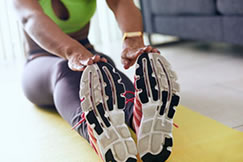 Simple foot pain can be underlying signs of more serious foot problems, such as plantar fasciitis or hammertoe. However, stretching your toes sideways may be one potential exercise that can help treat your feet and prevent foot pain. Although stretching seems to be a simple activity, it can greatly improve the overall health of your feet.
Simple foot pain can be underlying signs of more serious foot problems, such as plantar fasciitis or hammertoe. However, stretching your toes sideways may be one potential exercise that can help treat your feet and prevent foot pain. Although stretching seems to be a simple activity, it can greatly improve the overall health of your feet.
Stretching the feet is a great way to prevent injuries. If you have any concerns with your feet contact Dr. Steven Schwartz from Pennsylvania. Our doctor will assess your condition and provide you with quality foot and ankle treatment.
Stretching Your Feet
Being the backbone of the body, the feet carry your entire weight and can easily become overexerted, causing cramps and pain. As with any body part, stretching your feet can serve many benefits. From increasing flexibility to even providing some pain relief, be sure to give your feet a stretch from time to time. This is especially important for athletes or anyone performing aerobic exercises, but anyone experiencing foot pain or is on their feet constantly should also engage in this practice.
Good ways to stretch your feet are:
- Crossing one leg over the others and carefully pull your toes back. Do 10-20 repetitions and repeat the process for each foot
- Face a wall with your arms out and hands flat against the wall. Step back with one foot and keep it flat on the floor while moving the other leg forward. Lean towards the wall until you feel a stretch. Hold for 30 seconds and perform 10 repetitions for each foot
- Be sure not to overextend or push your limbs too hard or you could risk pulling or straining your muscle
Individuals who tend to their feet by regular stretching every day should be able to minimize foot pain and prevent new problems from arising.
If you have any questions, please feel free to contact our offices located in Chambersburg and Mcconnellsburg, PA. We offer the newest diagnostic and treatment technologies for all your foot care needs.
Foot Care for Diabetics
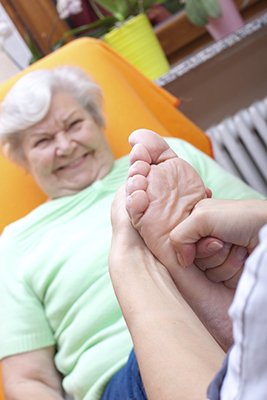 It is important for people with diabetes to take extremely good care of their feet. Scientific research has been done to figure out why diabetics tend to have foot problems. Researchers have found that neuropathy, or nerve damage, can prevent an individual from being able to sense pain in their feet. Fortunately, there are ways to prevent foot-related diabetic complications from happening. Having good control of your blood sugar will protect viral nerve function. A lot of problems can also be prevented by simply having a healthy lifestyle, and getting routine check-ups.
It is important for people with diabetes to take extremely good care of their feet. Scientific research has been done to figure out why diabetics tend to have foot problems. Researchers have found that neuropathy, or nerve damage, can prevent an individual from being able to sense pain in their feet. Fortunately, there are ways to prevent foot-related diabetic complications from happening. Having good control of your blood sugar will protect viral nerve function. A lot of problems can also be prevented by simply having a healthy lifestyle, and getting routine check-ups.
Diabetic foot care is important in preventing foot ailments such as ulcers. If you are suffering from diabetes or have any other concerns about your feet contact Dr. Steven Schwartz from Pennsylvania. Our doctor can provide the care you need to keep your pain free and on your feet.
Diabetic Foot Care
Diabetes affects millions of people every year. Diabetes can damage blood vessels in many parts of the body, including the feet. Because of this, taking care of your feet is essential if you have diabetes, and having a podiatrist help monitor your foot health is highly recommended.
The Importance of Caring for Your Feet
- Routinely inspect your feet for bruises or sores.
- Wear socks that fit your feet comfortably.
- Wear comfortable shoes that provide adequate support.
Patients with diabetes should have their doctor monitor their blood levels because blood sugar levels play such a huge role in diabetic care. Monitoring these levels on a regular basis is highly advised.
It is always best to inform your healthcare professional of any concerns you may have regarding your feet, especially for diabetic patients. Early treatment and routine foot examinations are keys to maintaining proper health, especially because severe complications can arise if proper treatment is not applied.
If you have any questions please feel free to contact one of our offices located in Chambersburg and Mcconnellsburg, PA for the newest diagnostic and treatment technologies for all your foot and ankle needs.
Traditional Shoes for Women are also Bad for Feet
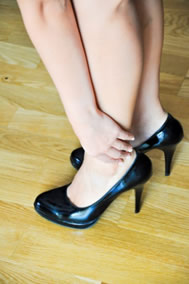 Women are starting to choose shoes that they can easily walk in. Shoe brands that are known for making comfortable shoes are starting to upgrade their designs in order to make their shoes fashionable as well. Some podiatrists are also working to create shoes that are not only comfortable, but fashionable too. Dr. Joan Oloff is a Californian podiatrist who is bothered by the fact that traditional women’s shoes are bad for the feet. She has worked to minimize the angle of the foot inside the shoe.
Women are starting to choose shoes that they can easily walk in. Shoe brands that are known for making comfortable shoes are starting to upgrade their designs in order to make their shoes fashionable as well. Some podiatrists are also working to create shoes that are not only comfortable, but fashionable too. Dr. Joan Oloff is a Californian podiatrist who is bothered by the fact that traditional women’s shoes are bad for the feet. She has worked to minimize the angle of the foot inside the shoe.
High heels have a history for causing foot and ankle problems. If you have any concerns about your feet or ankles, contact Dr. Steven Schwartz from Pennsylvania. Our doctor can provide the care you need to keep your pain free and on your feet.
Effects of High Heels on the Feet
High heels are popular shoes among women because their style and societal appeal. Despite this, they can still cause many health problems if worn too frequently.
What parts my body will be affected by high heels?
- Ankle Joints
- Achilles Tendon – may shorten and stiffen with prolonged wear
- Balls of the Feet
- Knees – heels cause the knees to bend constantly, creating stress on them
- Back – they decrease the spine’s ability to absorb shock, which may lead to back pain. Also, the vertebrae of the lower back may compress.
What kinds of foot problems can develop from wearing high heels?
- Corns
- Calluses
- Hammertoe
- Bunions
- Morton’s Neuroma
- Plantar Fasciitis
How can I still wear high heels and maintain foot health?
If you want to wear high heeled shoes, make sure that you are not wearing them every day, as this will help prevent long term physical problems. Try wearing thicker heels as opposed to stilettos to distribute weight more evenly across the feet. Always make sure you are wearing the proper shoes for the right occasion, such as sneakers for exercising. If you walk to work, try carrying your heels with you and changing into them once you arrive at work. Adding inserts to your heels can help cushion your feet and absorb shock. Full foot inserts or metatarsal pads are available.
If you have any questions please feel free to contact our offices located in Chambersburg and Mcconnellsburg, PA. We offer the newest diagnostic tools and technology to treat your foot and ankle needs.
Derwin James Undergoes Foot Surgery
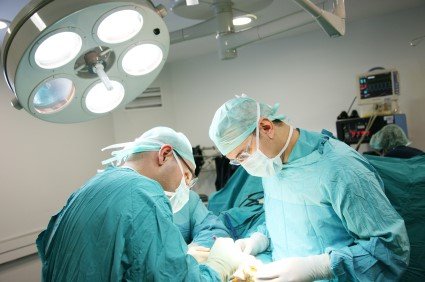 Florida State defensive back Derwin James recently underwent surgery for a minor fracture in his foot. Although there isn’t an exact timetable for his return, he has stated that he plans to be back in time for the season opener on September 5th. James was ranked the nation’s #1 safety coming out of highschool, and number #6 overall in the 2015 class.
Florida State defensive back Derwin James recently underwent surgery for a minor fracture in his foot. Although there isn’t an exact timetable for his return, he has stated that he plans to be back in time for the season opener on September 5th. James was ranked the nation’s #1 safety coming out of highschool, and number #6 overall in the 2015 class.
Foot surgery is sometimes necessary to fix a foot ailment. To learn more, contact Dr. Steven Schwartz from Pennsylvania. Our doctor can provide the care you need to keep you pain-free and on your feet.
When Is Surgery Necessary?
Foot and ankle surgery is generally reserved for cases in which less invasive, conservative procedures have failed to help with the problem. Some of the cases in which surgery may be necessary are:
- Removing foot deformities like bone spurs and bunions
- Severe arthritis that has caused bone issues
- Cosmetic reconstruction
What Types of Surgery Are There?
The type of surgery you receive will depend on the nature of the problem you have. Some of the possible surgeries include:
- Bunionectomy for painful bunions
- Surgical fusion for realignment of bones
- Neuropathy decompression surgery to treat nerve damage
Benefits of Surgery
Although surgery is usually a last resort, it can provide more complete pain relief compared to non-surgical methods and may allow you to finally resume full activity.
Surgical techniques have also become increasingly sophisticated. Techniques like endoscopic surgery allow for smaller incisions and faster recovery times.
If you have any questions please feel free to contact our office located in Chambersburg and Mcconnellsburg, PA. We offer the newest diagnostic and treatment technologies for all your foot and ankle needs.
How to Get Rid of Bunions
 Hallux valgus, which is more commonly known as a bunion, is a deformity of the joint at the base of the big toe. Most people who have bunions develop them from wearing uncomfortable shoes for a long period of time. Women are more likely to have bunions compared to men because they often wear high heels. Bunions are not a life threatening condition; however they can negatively impact one’s quality of life. There are a few non-surgical options for those wishing to treat their bunions. Physiotherapy and the use of devices such as bunion splints and toe spacers can work to alleviate bunion pain; however they may not be effective in the long run.
Hallux valgus, which is more commonly known as a bunion, is a deformity of the joint at the base of the big toe. Most people who have bunions develop them from wearing uncomfortable shoes for a long period of time. Women are more likely to have bunions compared to men because they often wear high heels. Bunions are not a life threatening condition; however they can negatively impact one’s quality of life. There are a few non-surgical options for those wishing to treat their bunions. Physiotherapy and the use of devices such as bunion splints and toe spacers can work to alleviate bunion pain; however they may not be effective in the long run.
Bunion surgery usually occurs after non-surgical methods have proved to be ineffective. If you have any concerns, contact Dr. Steven Schwartz from Pennsylvania. Our doctor will assess your injury and provide you with quality treatment.
What is a Bunion?
A bunion is formed of swollen tissue or an enlargement of boney growth, usually located at the base joint of the toe that connects to the foot. The swelling occurs by the bones in the big toe shifting inward, which impacts the other toes of the foot. This causes the area around the base of the big toe to become inflamed and painful.
Why do Bunions Form?
- Genetics – susceptibility to bunions are often hereditary
- Stress on the feet – poorly fitted and uncomfortable footwear that places stress on feet, such as heels, can cause bunions to form
How are Bunions Diagnosed?
Doctors often perform two tests – blood tests and x-rays – when trying to diagnose bunions, especially in the early stages of development. Blood tests help determine if the foot pain is being caused by something else, such as arthritis, while x-rays provide a clear picture of your bone structure to your doctor.
How are Bunions Treated?
- Refrain from wearing heels or similar shoes that cause discomfort
- Select wider shoes that can provide more comfort and reduce pain
- Anti-inflammatory and pain management drugs
- Orthotics or foot inserts
- Surgery
If you have any questions, please feel free to contact our office located in Chambersburg and Mcconnellsburg, PA. We offer the newest diagnostic and treatment technologies for all your foot care needs.
Read more about bunions.
Beach Running May be Beneficial
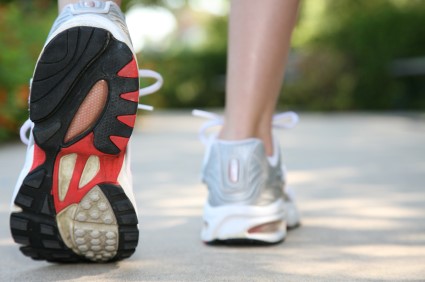 Experts say that beach running can be a heart-pumping and challenging workout. However, little preparation prior to running on the beach can make one more susceptible to foot injuries. Beach running is something that needs to be eased into. One cannot simply run several miles on the beach without prior experience doing so. Researchers have found that running on soft sand can actually put more strain on the muscles and joints compared to harder sand. This is because softer sand causes the muscles to work extra hard in order to stabilize the leg.
Experts say that beach running can be a heart-pumping and challenging workout. However, little preparation prior to running on the beach can make one more susceptible to foot injuries. Beach running is something that needs to be eased into. One cannot simply run several miles on the beach without prior experience doing so. Researchers have found that running on soft sand can actually put more strain on the muscles and joints compared to harder sand. This is because softer sand causes the muscles to work extra hard in order to stabilize the leg.
Runners can still be prone to running injuries even with proper precautions. If you are suffering from a running injury, contact Dr. Steven Schwartz from Pennsylvania. Our doctor can provide the care you need to keep your pain free and on your feet.
How to Prevent Running Injuries
Many common running injuries are caused by overuse and overtraining. When the back of the kneecap starts wearing out and starts causing pain in your knee, this is commonly referred to as runner’s knee. Runner’s knee is a decrease in strength in your quadriceps and can occur if you’re not wearing properly fitted or supporting shoes. To prevent runner’s knee, focusing on hip strengthening is a good idea, as well as strengthening your quads to keep the kneecaps aligned.
What Are Some Causes of Running Injuries?
- One cause of a common running injury is called iliotibial band syndrome.
- Plantar fasciitis is also another common injury.
- Stress fractures can occur from overtraining, lack of calcium, or even your running style.
Best Ways to Prevent Running Injuries
- Wear footwear that fits properly and suits your running needs.
- Running shoes are the only protective gear that runners have to safeguard them from injury.
- Make a training schedule. Adding strengthening exercises as well as regular stretching can help keep you strong and limber and can lessen the possibility of injuries.
- Stretching keeps muscles limber, this will help you gain better flexibility.
If you have any questions, please feel free to contact our offices located in Chambersburg and Mcconnellsburg, PA. We offer the newest diagnostic tools and technologies to treat your foot and ankle needs.
Read more about How to Prevent Running Injuries
Hyperhidrosis and Your Feet
 Hyperhidrosis is the medical term for excessive sweating. Although hyperhidrosis only affects 3% of the global population, it is still viewed as a serious health condition. People who suffer from the condition are often self-conscious, anxious and depressed. Hyperhidrosis usually affects the hands, feet, and forehead of people who have it. Those with hyperhidrosis know that there is a strong body odor that is caused by the condition. It is important to wash every day and shave under your arms. Bacteria and moisture can easily become trapped in hair so it is recommended that you shave it off.
Hyperhidrosis is the medical term for excessive sweating. Although hyperhidrosis only affects 3% of the global population, it is still viewed as a serious health condition. People who suffer from the condition are often self-conscious, anxious and depressed. Hyperhidrosis usually affects the hands, feet, and forehead of people who have it. Those with hyperhidrosis know that there is a strong body odor that is caused by the condition. It is important to wash every day and shave under your arms. Bacteria and moisture can easily become trapped in hair so it is recommended that you shave it off.
If you are suffering from hyperhidrosis contact Dr. Steven Schwartz from Pennsylvania. Our doctor will treat your foot and ankle needs.
Hyperhidrosis of the Feet
Hyperhidrosis is a rare disorder that can cause people to have excessive sweating of their feet. This can usually occur all on its own without rigorous activity involved. People who suffer from hyperhidrosis may also experience sweaty palms.
Although it is said that sweating is a healthy process meant to cool down the body temperature and to maintain a proper internal temperature, hyperhidrosis may prove to be a huge hindrance on a person’s everyday life.
Plantar hyperhidrosis is considered to be the main form of hyperhidrosis. Secondary hyperhidrosis can refer to sweating that occurs in areas other than the feet or hands and armpits. Often this may be a sign of it being related to another medical condition such as menopause, hyperthyroidism and even Parkinson’s disease.
In order to alleviate this condition, it is important to see your doctor so that they may prescribe the necessary medications so that you can begin to live a normal life again. If this is left untreated, it is said that it will persist throughout an individual’s life.
A last resort approach would be surgery, but it is best to speak with your doctor to find out what may be the best treatment for you.
If you have any questions please feel free to contact one of our offices located in Chambersburg and Mcconnellsburg, PA. We offer the newest diagnostic and treatment technologies for all your foot and ankle needs.
Read more about hyperhidrosis of the feet.

